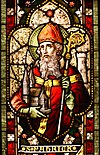Cinnia
Saint Cinnia | |
|---|---|
| Born | 5th century Ireland |
| Died | Ireland |
| Feast | 1 February |
| Patronage | Catholic Church, Eastern Orthodox Church |
| Influences | Saint Patrick |
Cinnia, or Cynnia, was an Irish saint who lived during the 5th century. She was a princess of Ulster, the only daughter of Echu (or Eochaidh), a king in Ireland.[1]
She converted to Christianity, but her father wanted her to marry Corburac, so Saint Patrick intervened on her behalf.[2][3] Her father agreed to allow her to become a nun, on the condition that Patrick "promised him eternal life without compelling him to be baptized".[3] Patrick agreed, and Cinnia entered the Monastery of Druimduchan, a large community of virgins, under the care of the abbess Cathuberis, where Cinnia lived until her death.[2][4] Cinnia was responsible for the conversion of many pagans and was well known for her miracles, which occurred both during her life and after she died.[3][4]
Hagiographer Agnes Dunbar states that Cinnia might have been Patrick's sister, although that is unlikely.[3] Her feast day is February 1.[2][3]
References[edit]
- ^ "Cinna (Cinne, or Cinnia), Saint", The Cyclopedia of Biblical, Theological, and Ecclesiastical Literature. (James Strong and John McClintock, eds.); Harper and Brothers; NY; 1880
 This article incorporates text from this source, which is in the public domain.
This article incorporates text from this source, which is in the public domain.
- ^ a b c Hutchison-Hall, John (Ellsworth) (2013). Orthodox Saints of the British Isles: Volume One (January - March). St. Eadfrith Press. p. 93. ISBN 978-0-615-92580-6. OCLC 1064010329.
- ^ a b c d e Dunbar, Agnes B.C. (1901). A Dictionary of Saintly Women. Vol. 1. London: George Bell & Sons. p. 91.
- ^ a b O'Leary, James (1897). The Most Ancient Lives of Saint Patrick: Including the Life by Jocelin. New York: P.J. Kenedy. pp. 224–225.

